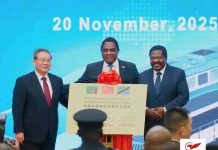Africa-Press – Zambia. The choreography of diplomacy around Lusaka this week has been deliberate. Two days ago, President Hakainde Hichilema hosted China Railway Construction Corporation (CRCC) Chairman Dai Hegen at State House, declaring that “TAZARA is more than a railway; it is an economic artery envisioned by our founding leaders.” Today, he meets Chinese Premier Li Qiang in the first visit by a Chinese premier in twenty-eight years.
At the same moment, the United States Embassy in Lusaka published a pointed historical reminder about its role in rescuing TAZARA in the 1980s. The timing is not accidental. It reflects the renewed competition between Beijing and Washington for influence in one of Africa’s most strategically placed nations.
The Chinese Premier’s visit comes as Zambia emerges from a prolonged financial crisis and a $13.4 billion debt restructuring. China is owed $5.7 billion, making it Zambia’s largest official creditor. Reuters noted this morning that Beijing views Zambia as a model Belt and Road partner that survived a debt storm “with Chinese assistance,” and now offers fresh space for investment in copper, infrastructure and equipment exports.
Zambia’s economy is forecast by the World Bank to grow by 6.5 percent next year, one of the strongest projections on the continent. In Beijing’s calculus, this is the moment to lock in long-term economic and political leverage.
Washington sees the same opening. Just as news of Li’s visit broke, U.S. Secretary of State Marco Rubio called President Hichilema, pledging deeper cooperation on investment, health systems and economic transformation. Days earlier, the U.S. announced a $1.5 billion health programme for Zambia running from 2026 to 2031.
And on Thursday last week, Donald Trump Jr. visited State House. In geopolitical terms, these signals communicate one message: the United States does not intend to concede Zambia to Beijing without contest.
The U.S. Embassy’s throwback post today was unusually pointed. It reminded Zambians that when TAZARA collapsed only few years after opening in the 1970s, it was the United States that “provided over $45 million in grant assistance” and trained the workforce needed to keep the line alive.
“Now that’s partnership,” the Embassy wrote. In diplomatic language, this was a direct counter-narrative to China’s claims of being the indispensable partner on TAZARA.
Washington is reviving its historical role to compete for influence over Zambia’s transport corridors just as Beijing moves to reinforce its own.
China’s current investment posture is broader and more coordinated. Reuters quoted Eric Olander of the China-Global South Project saying that Li’s visit is designed “to bolster China’s presence in a strategically vital country,” particularly after this year’s spill at a Chinese-run copper plant dumped 50,000 cubic metres of acidic water into the Kafue River.
Beijing knows the incident has become an investor issue and is moving to stabilise its reputation and support its mining firms before Zambia’s political temperature rises.
CRCC’s meeting with Hichilema was a key precursor. The President encouraged Chinese investors to expand into power generation, saying “reliable energy will be critical to maximising the benefits of the TAZARA Corridor.” The reference was deliberate. Zambia’s ongoing power crisis threatens mining output, industrial expansion and regional rail efficiency.
China is positioning itself not only as a financier of rail rehabilitation but as a partner in solving the country’s energy deficit, a sector Washington is also eyeing through private-sector-led investment.
The broader regional context is equally important. China recently approved what analysts describe as a massive refurbishment plan for TAZARA, which many see as Beijing’s response to the U.S. and EU-backed Lobito Corridor running through Angola and the DRC. The Lobito project aims to pull Congolese and Zambian minerals toward Atlantic markets, reducing dependence on Chinese trade routes.
Beijing’s renewed focus on TAZARA is therefore not symbolic; it is strategic counter-infrastructure designed to protect its access to copper, cobalt and manganese.
Today’s diplomacy in Lusaka is therefore not a routine bilateral visit. It is part of a wider competition for access, influence and strategic transport corridors. Zambia, sitting between mineral-rich neighbours and two oceans, is a pivot state.
President Hichilema appears intent on balancing both superpowers. He welcomes Li Qiang with full honours while U.S. officials signal their continued presence through capital injections and well-timed public messaging.
For More News And Analysis About Zambia Follow Africa-Press







